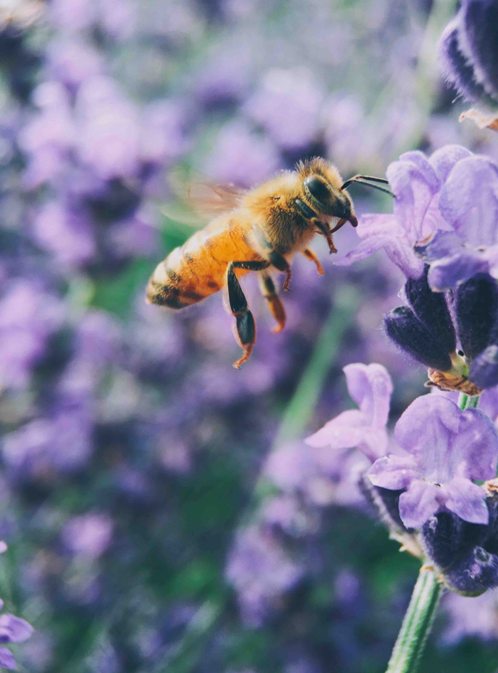Pollinators are responsible for about 75% of the food we eat. The European honeybee is the most well-known but our native bees are also critically important.

We can help our native bees and gardens by reducing or eliminating the use of pesticides and providing shelter as well as food and water.
About 70% of our native bees are ground nesting. Reduce the risk of conflicts with ground nesting bees by creating an inviting habitat away from prime gardening areas. Leave warm south facing spaces open for bees to establish their in-ground nests.
Wood and cavity nesting bees, like the leaf cutter bee, make up about 30% of our native bee population. Others nest in hollow plant stems so leave these, which act as their homes, stand for winter. Bumblebees nest in abandoned animal burrows, tree cavities, grassy areas, or under fallen leaves. A colony usually contains a few hundred bees. All members of the colony die in the fall except the fertilized queens. The queens look for new homes the following spring.
Support our native bees by planting a variety of bee attracting flowers. The plants provide food and shelter and help attract the native bees to your landscape and bee houses. Include plants with different colors and shaped flowers. Grow lots of purple, blue, white, and yellow flowers that are favored by bees. Plant flowers in large numbers; you will enjoy the display, the garden will require less maintenance, and you will get the attention of the bees you are trying to attract. Plus, bees use less energy when they can gather lots of food from a smaller area.
Make sure you have something in bloom throughout the growing season. Spring bulbs, wildflowers and perennials provide essential food that is often in limited supply early in the season. Fall flowering plants provide needed energy supplies as the bees and other pollinators prepare for winter.
Bigger flowers are not always better. Double flowers may be showy, but they have less nectar and pollen. The multiple layers of petals hinder access to what nectar and pollen they contain.
Grow some herbs in the garden and containers for you and the bees. Let some go to flower and watch for visiting bees on thyme, borage, oregano, and other herb flowers. Grow native plants whenever possible. They are a richer source of nectar and pollen than cultivated plants. Native bees and other beneficial insects have evolved with these plants, providing a mutual benefit.
Leave leaf litter in place and leave healthy perennials including grasses stand for winter. These provide homes for some bees and other beneficial insects. Wait as long as possible to remove them in spring so you don’t interrupt their hibernation.
Increase living quarters by making your own native mason bee houses. Just be sure you provide a properly designed, clean home with needed winter protection. Do your homework first to make sure you are not harming the native bees you are trying to support. The easiest method uses a bundle of hollow sticks such as bamboo, reeds, or sumac. Cut them into short segments and remove three to five inches of pith with wire or a drill. Consider painting the front to make an inviting entrance for the bees. Bundle the stems together with wire or place in a bucket or can.
Or create a solitary bee house from a block of untreated wood. Drill holes into, but not through a block of untreated wood. The holes should be three to five inches deep and about 5/16 of an inch in diameter for mason bees. Nesting tubes inserted into the holes makes for easier cleaning and storage that prevents debris and disease from building up one season to the next.
Mount the bee house on the southeast side of a post, fence or building. Make sure to provide a nearby mud puddle the bees will use to seal off the individual development chambers in the holes.
Creating a bee friendly landscape not only increases your garden’s productivity but also the number of songbirds and beneficial insects that visit your garden. That means fewer garden pests and a more beautiful garden for you to enjoy all season long.
Melinda Myers has written more than 20 gardening books, including Small Space Gardening. She hosts the “How to Grow Anything” DVD series and the Melinda’s Garden Moment TV & radio segments. Her website is MelindaMyers.com.




Comment here